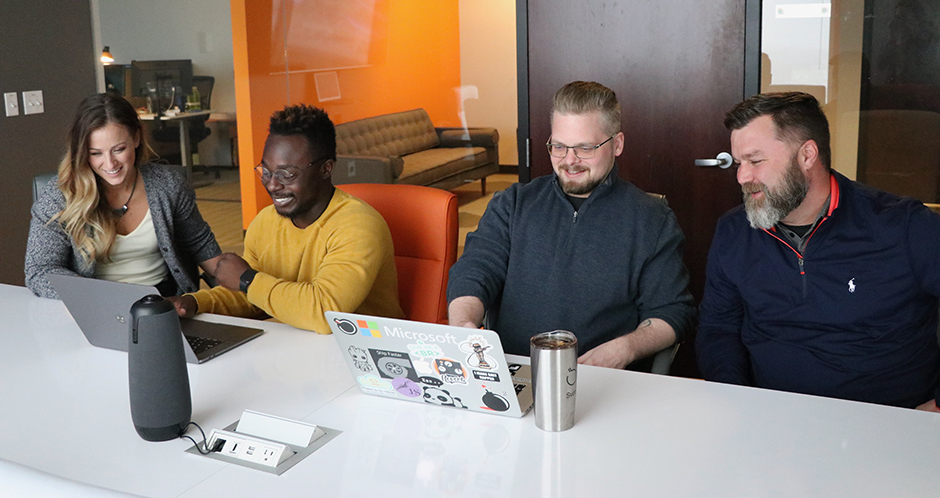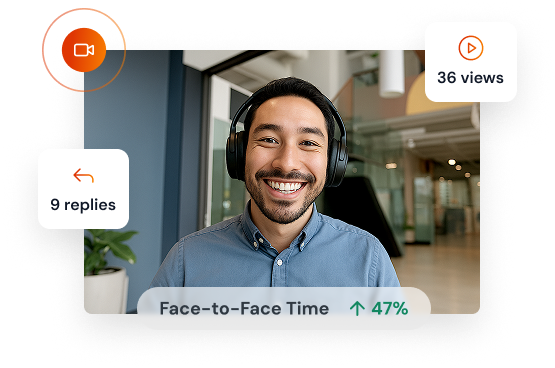Table of Contents
- 1. Foster Genuine Interaction With Digital Tools
- 2. Amplify Warmth
- 3. Use Video Messages for Face-to-Face Resonance
- 4. Make the Most of 1:1s
- 5. Show Respect for Employees’ Time
- 6. Link Performance to Purpose
- 7. Normalize a “Cameras On” Culture
- 8. Use Meeting Chats Intentionally
- 10. Make Sure to Celebrate
- 11. Schedule Fun Virtual Employee Engagement Activities
- 12. Get Together in Person
- 13. Break Free from Time Constraints with Async Tools
- Frequently Asked Questions about Remote Employee Engagement
The pandemic fundamentally changed how we work — and just when we think we’ve settled into a “new norm,” the landscape shifts again. What started as a temporary shift to remote and hybrid teams has become a continuous evolution in workplace dynamics.
According to recent Gallup data, 55% of U.S.-based employees are now following a hybrid work model (with some combination of time at home and some time in the office), 24% working entirely remotely (a dramatic increase from pre-pandemic figures of only 6%), and 19% fully on-site (although that has been trending upwards, especially in larger companies).
In the post-COVID workplace, creating and sustaining employee engagement through human resource management is harder than ever.
So how can HR professionals keep all of their people engaged, happy and productive? Which employee engagement trends have proven themselves to create connection, purpose and satisfaction among distributed teams? And which still work in 2025?
We’ve put together a playbook on how to engage remote workers — as well as those that make it into the office, on the regular or on occasion.
1. Foster Genuine Interaction With Digital Tools
Virtual teams could not exist without digital collaboration tools. Platforms like Slack, Zoom and Asana are the vital connective tissue that allow us to keep in touch regardless of physical location or time zone. Beyond their practical functions, they create spaces for personal connections and spontaneity.
Want to make sure every team member feels equipped, included and valued regardless of where they work?
Here are some of our favorite tools for remote team engagement:
Project Management: Airtable, Trello, Asana, Monday.com
Communication: Slack, Microsoft Teams, Zoom
File Sharing & Documentation: Google Workspace, Dropbox, Notion, Confluence
Brainstorming & Collaboration: Miro, FigJam, Microsoft Whiteboard, Conceptboard, Mural, Canva Whiteboard, Lucidchart
2. Amplify Warmth
This is a concept called out by New York Times bestselling author, Daniel Coyne in The Culture Playbook: 60 Highly Effective Actions to Help Your Group Succeed.
According to Daniel’s research, warmth needs to be actively demonstrated — not just felt internally — to build psychological safety and strong relationships within organizations.
How? Through warm body language and facial expressions, being fully present in interactions and expressing appreciation specifically and frequently.
3. Use Video Messages for Face-to-Face Resonance
Learning how to improve employee engagement long term means understanding how to communicate clearly and effectively on a personal level.
When it comes to conveying warmth, video is a powerful tool because it allows for face-to-face communication — something we all crave, especially remote workers.
Here at BombBomb, video messages are an integral part of our culture. If your company isn’t using video yet, here are a couple ideas to get you going.
New Employee Onboarding
Joining a new company can be stressful. There’s a lot of information for new hires to absorb in a short amount of time.
Video optimizes the onboarding process so that new employees feel infinitely more comfortable.
You can use video throughout the onboarding process to:
- Explain complicated paperwork
- Review benefits packages
- Remind new employees what you need them to submit (and when you need it by)
- Let your new employees know what to expect on their first days with the company
Check out this article for ideas on how to improve onboarding success with video.
And another tip: Using a tool like a screen recorder can help you walk new employees through complicated paperwork just like you’re sitting next to them.
Vital Company Updates
Some announcements can’t wait for the next All Hands meeting. And some messages are so critical, you can’t risk the misinterpretation of tone that so often happens with text-only emails.
Video brings your leaders directly into the picture — in a scalable way. For HR professionals, it shows employees there’s another human at the other end of their benefits paperwork and those mandatory training sessions.
Use video to:
- Communicate time-sensitive information like open enrollment dates
- Share significant company news and milestones
- Guide employees through organizational transitions
- Encourage participation in employee engagement surveys
4. Make the Most of 1:1s
Nothing can replace one on one time with your direct manager for guidance and accountability.
Too often managers deprioritize these check-ins in favor of “more important” client-facing meetings and other pressing tasks. However, canceling or rescheduling 1:1s makes employees feel less valued and connected.
Make these meetings consistent and frequent. Have an agenda ready so that you use the time effectively, while leaving room for non-work topics too.
5. Show Respect for Employees’ Time
Speaking of using time effectively, there’s a reason there so many memes are devoted to the old adage, “This could have been an email.” If you’re going to schedule a meeting, have a clear purpose.
Only invite those who are necessary, and don’t schedule 30 minutes for something that can be done in fifteen.
Showing up on time (or within the first 5 minutes) conveys respect. If something unexpected comes up, communicate updates as soon as you can. And whatever you do, don’t arrive late and then brag about being double- or triple-booked.
Newsflash: none of us are able to be in two places at once. Channel your inner Oprah and accept, reschedule and delegate meetings mindfully.
6. Link Performance to Purpose
A recent Gallup survey found that when employees feel connected to their company’s purpose, turnover drops by 8.1% and profitability rises by 4.4%.
Yet, only 30% of U.S. employees strongly agree that their company’s mission makes their job feel meaningful. The missing link? Leaders who make purpose personal.
One of the most effective ways to build this connection is by consistently tying individual performance to organizational success (and other higher order goals). This approach, rooted in the Impact pillar of Reworking Leadership’s SHIFT model, ensures employees feel valued and motivated — leading to stronger teams and better business outcomes.
“When people see how their daily work contributes to something bigger — whether it’s their team’s success, the company’s mission, or a broader social impact — they stay engaged and invested. This is consistent across all generations in the workforce,” says Rachael Lowell Ellison, founder of Reworking Leadership.
7. Normalize a “Cameras On” Culture
Nothing is more disengaging than a sea of blank Zoom screens. Are they doing laundry? Sleeping? Binge watching Severance?
Have we mentioned that face-to-face rapport is part of human evolution and critical to building connection and wellbeing? Well, it’s worth saying again. Especially considering that, according to some experts, we’re in the midst of a loneliness epidemic.
Seeing colleagues regularly helps maintain social connections and combat isolation. This is how to make remote employees feel included when they might otherwise go days without meaningful visual human interaction.
For new team members, seeing faces helps build familiarity and accelerates relationship building in the absence of in-person interactions. For leaders and managers, modeling camera use demonstrates commitment to transparency and accessibility, important factors in building trust with distributed teams.
That said, don’t go overboard. It’s important to allow flexibility for legitimate camera-off situations and respect for occasional personal circumstances.
8. Use Meeting Chats Intentionally
Chats are a great opportunity to engage employees during virtual meetings, but be intentional about it.
Plant an icebreaker question in the chat (like “What’s one thing you see outside your window right now?” or “If you could teleport anywhere for lunch today, where would you go?”) to encourage participation before the formal meeting begins.
Encourage backchannel resource sharing where participants can drop relevant links, documents, or references that support the discussion. Use the chat for real-time feedback during presentations with prompts like “What resonated most?” or “Drop a question mark if you need clarification.”
For really large meetings, designate a chat moderator to acknowledge questions and comments, ensuring quieter team members’ contributions are recognized.
Avoid having side conversations via chat, however. Save those for after the meeting wraps.
10. Make Sure to Celebrate
Showing appreciation engages and motivates employees. It also promotes productivity in job responsibilities and retention.
According to Forbes, when leaving a job, 79% of employees reported a “lack of appreciation” as their reason for quitting. Make a kudos board to publicly call out stellar work. Build in reminders to celebrate birthdays and work anniversaries.
And don’t be afraid to mix real objects with virtual events! Surprise everyone with a pizza delivery halfway through a meeting! A little bit of advance planning makes it easy to ship employees tokens of appreciation like wine glasses, bday hats, or coffee mugs. And going the extra mile makes virtual employee engagement that much more effective.
Tip: Use personalized video messages to congratulate employees on promotions, important milestones, and to let them know how appreciated and valued they are. And take a look at this post for a more comprehensive look at employee retention and recruitment.
11. Schedule Fun Virtual Employee Engagement Activities
It’s fun — and even productive — to break long meetings up with games and a bit of non-work frivolity.
Here are some of our favorite remote employee engagement activities:
- Virtual Escape Rooms — Many companies now offer remote versions where teams solve puzzles together in breakout rooms
- Online Trivia Tournaments — Create custom rounds on platforms like Kahoot, mixing company-specific questions with general knowledge
- Virtual Cooking Classes — Send ingredient kits to employees’ homes and cook together with a professional chef
- Digital Scavenger Hunts — Challenge teams to find and photograph specific items in their homes within a time limit
- Remote Game Shows — Adapt classics like Family Feud or Jeopardy with company-related content
- Online Drawing Games — Use platforms like Drawasaurus or Skribbl.io for lighthearted artistic competition
- Virtual Book or Movie Clubs — Monthly discussions that rotate discussion leaders from different departments
- Virtual Wellness Challenges — Team step competitions, meditation sessions, or yoga classes
- Collaborative Playlists — Create team music collections for different moods or workday moments
- Virtual Talent Show — Showcase non-work-related skills and hidden talents across the organization
There are many other remote employee engagement ideas outside of these examples. If you’re looking for inspiration, ask your team what they’d enjoy, and ask peers at other organizations whey they do in this vein.
12. Get Together in Person
Some colleagues go years without ever being in the same room.
There’s nothing quite like meeting someone in person for the first time after only communicating with them over email and video. It takes the relationship to a whole new level.
These days, the point of off-sites is less about getting work done — so much of that can be done remotely. The real rewards of getting together come from the relationship building and intangible social benefits.
It turns out that human contact is still a thing. And worth investing in.
13. Break Free from Time Constraints with Async Tools
The digital revolution hasn’t just changed where we work—it’s transformed when we work. For teams scattered across time zones and schedules, asynchronous communication tools have become the great equalizer.
Record those crucial meetings and pair them with concise written summaries so team members can engage with important content on their own terms. No more forcing employees to log in at midnight just to stay in the loop.
Ditch the endless email threads that everyone dreads opening. Instead, encourage rich, personality-filled voice notes and quick video updates that convey tone, enthusiasm and nuance in ways text never could.
These bite-sized communications often deliver more authentic engagement in 60 seconds than a dozen emails ever could.
By embracing asynchronous tools strategically, you’re not just accommodating different schedules — you’re creating a more inclusive culture where everyone can contribute when they’re at their best.
Frequently Asked Questions about Remote Employee Engagement
Below are other frequently asked questions related to engaging remote and hybrid employees.
What are the different types of engaged employees?
Employees can be grouped into three different engagement buckets:
- Actively engaged
- Not engaged
- Actively disengaged
Actively engaged team members love what they do and are bought into the organization as a whole. They bring positivity to the workplace and create better experiences for peers. They also advocate on behalf of the brand. As a HR or people management leader, you want to replicate actively engaged employees as much as possible.
Employees who are not engaged make up the majority of most organizations. These individuals fulfill their core responsibilities only. They don’t seek out other opportunities to contribute and are disinterested in what is happening outside of their specific lane.
HR teams should aim to help people in this group become actively engaged and avoid slipping into active disengagement.
Actively disengaged employees are clearly unhappy. They bring negative energy to their roles and discourage peers from performing well or investing in the organization.
In some cases, it makes sense to work with actively disengaged employees to address their complaints. In others, it’s best for all involved to part ways.
What types of employee engagement goals should we set?
Setting employee engagement goals is important for staying on track. You need hard quantitative or qualitative evidence that your employee engagement efforts are working.
Here are some ideas on what you can measure along the lines of employee engagement:
- Employee wellbeing with anonymous pulse surveys
- Employee motivation and buy-in through cultural surveys
- Employee productivity with performance rubrics and standards
- Employee safety with targeted courses and assessments
- Employee turnover, retention and absenteeism with HR analytics
- Customer satisfaction through CSATs and NPS scores (as a proxy for customer support engagement)
What are some of the biggest drivers of employee engagement?
The strategies outlined in this article are intended to push key drivers of employee engagement in the right direction.
A few of these drivers include:
- Having the right tools needed to do a job successfully
- Feeling seen and valued by colleagues
- Perceiving fairness in the workplace
- Having ownership and autonomy over one’s work
For a deeper dive on how to drive employee engagement, check out our article here.
What is an employee engagement model?
An employee engagement model is a framework or system for how can leaders promote engagement across the organization. A model typically consists of processes, practices and key metrics specific to the business to help guide interventions and ongoing engagement activities.
Having an engagement model is helpful in companies of all sizes. They give direction and force leaders to think more strategically about how they engage workers.
What is an employee engagement action plan?
An employee engagement action plan outlines specific steps for addressing feedback or issues identified through engagement surveys. It’s similar to an engagement model in that it’s intended to provide structure for activities related to promoting employee engagement. However, it’s more targeted and based on recent insights.
Curious to give video messaging a try in your organization?
Try out BombBomb for two weeks free or book a demo to see it in action.






